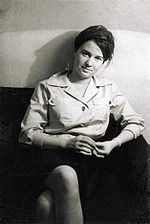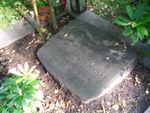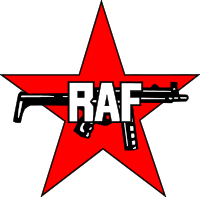Ulrike Meinhof
Ulrike Marie Meinhof (7 October 1934 – 9 May 1976) was a German left-wing militant. She co-founded the Red Army Faction (Rote Armee Fraktion) in 1970 after having previously worked as a journalist for the monthly left-wing magazine Konkret. She was arrested in 1972, and eventually charged with numerous murders and the formation of a criminal association. Before the trial concluded, Meinhof died in her cell in 1976.
Contents |
Early life

Ulrike Meinhof was born in 1934 in Oldenburg, Germany. In 1936, her family moved to Jena when her father, art historian Dr. Werner Meinhof, became director of the city's museum. Her father died of cancer in 1940, causing her mother to take in a boarder, Renate Riemeck, to make money. In 1946 the family moved back to Oldenburg because Jena fell under Soviet rule as a result of the Yalta agreement. Ulrike's mother, Dr. Ingeborg Meinhof, who worked as a teacher after World War II[1], died 8 years later from cancer. Renate Riemeck took on the role of guardian for Ulrike and her elder sister.
In 1955 she took her Abitur at a school in Weilburg. She then studied philosophy, sociology, Pädagogik (roughly pedagogy) and Germanistik (German studies) at Marburg where she became involved with reform movements.
In 1957 she moved to the University of Münster, where she met the Spanish Marxist Manuel Sacristán (who later translated and edited some of her writings) and joined the Socialist German Student Union, participating in the protests against the rearmament of the Bundeswehr and its involvement with nuclear weapons as proposed by Konrad Adenauer's government. She eventually became the spokeswoman of the local Anti-Atomtod-Ausschuss ('Anti-Atomic Death Committee'). In 1958, she spent a short time on the AStA (German: Allgemeiner Studierendenausschuss, or General Committee of Students) of the university and wrote articles for various student newspapers.
In 1959 she joined the Communist Party of Germany (KPD)—the banned German Communist Party—and later began work at the magazine konkret, serving as chief editor from 1962 until 1964. In 1961, she married the co-founder and publisher of konkret, Klaus Rainer Röhl. Their marriage produced twins, Regine and Bettina, on 21 September 1962, and lasted until their separation in 1967, which was followed by divorce the following year.
Establishment of the RAF
The attempted assassination of student activist Rudi Dutschke on 11 April 1968, provoked Meinhof to write an article in konkret demonstrating her increasingly militant attitude and containing perhaps her best-known quote:
| “ | Protest is when I say this does not please me.
Resistance is when I ensure what does not please me occurs no more.[2][3][4] |
” |
Later that year, her writings on arson attacks in Frankfurt protesting the Vietnam War resulted in her developing an acquaintance with the perpetrators, most significantly Andreas Baader and Gudrun Ensslin. She left her job at konkret in the early part of 1969 (later returning to vandalise the offices in May) and began her life as a guerilla.
Perhaps her last work as an individual was the writing and production of a film Bambule in 1970, urging female revolt and class warfare; by the time it was scheduled to be aired, she had become a wanted terrorist and its broadcast was delayed until 1997. More specifically, by that point she had participated in the breakout of Baader on 14 May 1970. During this assisted escape (from a research institute Baader was visiting rather than a prison), a 64-year old librarian was shot (several times with a pistol, resulting in critical liver damage) and two law enforcement officers were wounded. Baader and the three women involved were accused of attempted murder and a 10,000DM reward was offered for Meinhof's capture.[5]
Action in the RAF and arrest
In the next two years Meinhof participated in the various bank robberies and bombings executed by the group. She and other RAF members attempted to kidnap her children so that they could be sent to a camp for Palestinian orphans and educated there according to her desires; however, the twins were intercepted in Sicily and returned to their father, in part due to the intervention of Stefan Aust.[6]
During this period, Meinhof wrote or recorded many of the manifestos and tracts for the RAF. The most significant of these is probably The Concept of the Urban Guerrilla, a response to an essay by Horst Mahler, that attempts to set out more correctly their prevailing ideology. It also included the first use of the name Rote Armee Fraktion and, in the publications of it, the first use of the RAF insignia.[7] Her practical importance in the group, however, was often overstated by the media, the most obvious example being the common name Baader-Meinhof gang for the RAF. (Gudrun Ensslin is often considered to have been the effective female co-leader of the group rather than Meinhof.)
On 22 October 1971, Meinhof, alongside Margrit Schiller and Gerhard Müller, was involved in a shoot out with a group of policemen in Hamburg during an attempted arrest. One policeman was shot six times and killed. Though Müller and Meinhof managed to get away, Schiller was arrested a few hours later.
On 14 June 1972, in Langenhagen, Fritz Rodewald, a teacher who had been providing accommodation to deserters from the U.S. Armed Forces, was approached by a stranger asking for an overnighting house the next day for herself and a friend. He agreed but later became suspicious that the woman might be involved with the RAF and eventually decided to call the police. The next day the pair arrived at Rodewald's dwelling while the police watched. The man was followed to a nearby telephone box and was found to be Gerhard Mueller who was armed. They then proceeded to arrest the woman – Ulrike Meinhof.
Imprisonment and death

In December 1972, Meinhof, who was awaiting trial, was called to testify at Horst Mahler's trial where Mahler questioned her about the statement of support the two had issued for the September 1972 massacre of Israeli athletes at the Munich Olympics. His questioning led her to say
How was Auschwitz possible, what was anti-Semitism? It used the hatred of the people of their dependence on money as a medium of exchange, their longing for communism. Auschwitz means that six million Jews were murdered and carted on to the rubbish dumps of Europe for being that which was maintained of them — Money-Jews. What had happened was that finance capital and banks, the hard core of the system of imperialism and capitalism, had diverted the people’s hatred of money and exploitation away from themselves and on to the Jews.[8]
After two years of preliminary hearings, Meinhof was sentenced to 8 years' imprisonment on 29 November 1974. Eventually Meinhof, Baader, Ensslin, and Raspe were jointly charged on 19 August 1975, with four counts of murder, fifty-four of attempted murder, and a single count of forming a criminal association. However before the trial was concluded, Meinhof was found hanged by a rope, fashioned from a towel, in her cell in the Stammheim Prison on 9 May 1976. It is highly probable that, if not for her death, she would have been sentenced to 'life imprisonment plus 15 years'. (The remaining three defendants received such a sentence[9], designed to minimize the possibility of early parole.)
The official verdict was that Meinhof had committed suicide. It was later discovered that she had become increasingly isolated from other RAF prisoners. Notes exchanged between them in prison included one by Gudrun Ensslin, describing her as 'too weak'. The official findings were not accepted by many in the RAF[10] and other militant organisations, and there are still some who doubt their accuracy and believe that she was murdered by the authorities. In 2001, the findings of the inquiry were published under the title Der Tod Ulrike Meinhofs. Bericht der Internationalen Untersuchungskommission.[11]
Meinhof's body was buried six days after her death, in Berlin-Mariendorf. In late 2002, following investigations by her daughter Bettina, it was discovered that her brain had been retained (apparently without permission) by a hospital in Magdeburg, following the autopsy performed as part of the investigation into Meinhof's death. Bernhard Bogerts, a psychiatrist from the local university who had examined the brain controversially claimed that Meinhof's 'slide into terror' might be due to surgery performed in 1962 to remove a brain tumour.[12] On Bettina's request, the brain was interred in Meinhof's burial place on 22 December 2002.
Portrayal in popular culture
The book Lieber wütend als traurig (Better Angry than Sad)[13] by Alois Prinz was intended as a mainly faithful account of Meinhof's 'lifestory' for adolescents.
Meinhof's life has been the subject, to varying degrees of fictionalisation, of several films and stage productions. Included in the former is Reinhard Hauff's 1986 account of the Stammheim trial, Margarethe von Trotta's 1981 Marianne and Juliane and Uli Edel's 2008 film The Baader Meinhof Complex. Of the latter there has been the 1990 opera Ulrike Meinhof by Johann Kresnik, the 1993 play Leviathan by Dea Loher, and the 2006 play Ulrike Maria Stuart by Austrian playwright Elfriede Jelinek.
Subtopia, a novel published in 2005 by Australian author and academic A.L. McCann, is partially set in Berlin and contains a character who is obsessed with Ulrike Meinhof and another that claims to have attended her funeral.
Meinhof is portrayed by German actress Martina Gedeck in the 2008 film Der Baader Meinhof Komplex.
Music
Marianne Faithfull's album Broken English had the title track dedicated to Meinhof.
The anarcho punk band Chumbawamba's 1990 album, Slap! featured an opening and closing track, both named after Meinhof. The first track was entitled Ulrike and featured lyrics which directly involved Ulrike Meinhof as the protagonist and the final track was purely instrumental (but unrelated to the first track) and was entitled "Meinhof". The album's liner notes included information and an article relating to the song Ulrike.
Electronica act Doris Days created a track entitled To Ulrike M., in which there is a passage spoken in German throughout the song, presumably an archived audio file from Ulrike Meinhof herself. This track has since been remixed by other electronica acts like Zero 7, Kruder & Dorfmeister, and The Amalgamation Of Soundz.
The German duo Andreas Ammer and F.M. Einheit released an album in 1996 entitled Deutsche Krieger, a substantial portion of which consists of audio recordings of and about Ulrike Meinhof.
London-based experimental group Cindytalk have an electronic side-project called Bambule, named after the Ulrike Meinhof film, which has released two records on Praxis Records (1996 & 2000.)
The Brazilian Rock band Legião Urbana has a song called "Baader-Meinhof Blues".
Refrain of song "Ludvig van Beethoven" from the Finnish popular-music band SIG goes "And nobody has heard about rock 'n' roll or Ulrike Meinhof's death"
Bibliography
- Karl Wolff oder: Porträt eines anpassungsfähigen Deutschen (/Karl Wolff or: A Portrait of an Adaptable German). Radio documentary. Director: Heinz Otto Müller. Hessischer Rundfunk, Abendstudio, 1964.
- Gefahr vom Fließband. Arbeitsunfälle – beobachtet und kritisch beschrieben. (/Dangers of the Assembly-Line. Industrial Accidents – observed and critically analysed). Radio documentary. Director: Peter Schulze-Rohr. Hessischer Rundfunk, Abendstudio, 1965.
- Bambule - Fürsorge - Sorge für wen? (/Bambule: Welfare - Providing for whom?) Wagenbach, 1971, (Republished 2002, ISBN 3-803-12428-X)
Works of the RAF
- Das Konzept Stadtguerilla, 1971[7]
- The Concept of the Urban Guerilla
- Stadtguerilla und Klassenkampf, 1972/1974[14]
- Urban Guerilla and Class Struggle
Posthumous collections of essays
- Deutschland, Deutschland unter anderem (Deutschland, Deutschland among Other Things), Wagenbach, 1995 (ISBN 3-803-12253-8)
- Die Würde des Menschen ist antastbar (The Dignity of Man Is Violable), Wagenbach, 2004 (ISBN 3-803-12491-3)
- Karin Bauer, ed. Everybody Talks about the Weather... We Don't: The Writings of Ulrike Meinhof, Seven Stories Press, New York, 2008 (ISBN 978-1583228319). A selection of Meinhof's writings published in konkret from 1960 to 1968, with a foreword by Elfriede Jelinek, translated by Luise von Flotow.
Notes
- ↑ http://www.powercat.de/portraits/meinhof.html, retrieved August 12, 2007
- ↑ Die Würde des Menschen ist antastbar. Aufsätze und Polemiken, by Meinhof. See Bibliography.
- ↑ English translation of 'From Protest to Resistance' from konkret, no. 5 (May 1968), p. 5. retrieved from German History in Documents and Images on 4 January 2010
- ↑ 'Vom Protest zum Widerstand' original German text from konkret, no. 5 (May 1968), p. 5. retrieved from German History in Documents and Images on 4 January 2010
- ↑ Image of a 'Wanted' poster for Meinhof dating from May 1970. Retrieved from BettinaRoehl.de on 2 January 2007.
- ↑ Neal Ascherson "A terror campaign of love and hate", The Observer, 28 September 2008.
- ↑ 7.0 7.1 Full text in German of Das Konzept Stadtguerilla from Baader-Meinhof.com, Retrieved 2 January 2007.
- Full Text English Translation by Anthony Murphy from GermanGuerilla.com, Retrieved 2 January 2007.
- [http://www.dhm.de/lemo/objekte/pict/NeueHerausforderungen_kampfschrift/index.html
- ↑ THE RED ARMY FACTION: ANOTHER FINAL BATTLE ON THE STAGE OF HISTORY by Jillian Becker in Terrorism: An International Journal, Vol. 5, No. 1/2, 1981 http://www.libertarian.co.uk/lapubs/cultn/cultn012.pdf accessed November 2008
- ↑ "Guilty as charged", Time Magazine, 9 May 1977
- ↑ Jan Carl Raspe's speech in court of 5 November 1976. Retrieved from Baader-Meinhof.com, 2 January 2007.
- ↑ (1979 ISBN 3-492-24058-5, republished 2001 ISBN 3-897-71952-5)
- ↑ Meinhof brain study yields clues, BBC News Online. Retrieved 3 January 2007.
- ↑ (1997 ISBN 3407809050)
- ↑ Full text in German of Stadtguerilla und Klassenkampf from Baader-Meinhof.com, Retrieved 2 January 2007.
Further references
Books
- Aust, Stefan: Der Baader-Meinhof Komplex, (1998, ISBN 3-442-12953-2)
- Bauer, Karin (editor): Everybody Talks About The Weather...We Don't. The writings of Ulrike Meinhof. Preface by Elfriede Jelinek (Seven Stories Press ISBN 978-1-58322-831-9)
- Becker, Jillian: Hitler's Children: The Story of the Baader-Meinhof Terrorist Gang, London 1977.
- Brückner, Peter: Ulrike Meinhof und die deutschen Verhältnisse (/Ulrike Meinhof and the German Situation) (1976, ISBN 978-3-8031-2407-4)
- Ditfurth, Jutta: Ulrike Meinhof (2007, ISBN 978-3-550-08728-8)
- Krebs, Mario: Ulrike Meinhof (1988, ISBN 3-49915642-3)
- Röhl, Bettina (Meinhof's daughter): So macht Kommunismus Spass (/Making Communism Fun), (2007, ISBN 978-3434506003)
Films
- Ulrike Marie Meinhof, a documentary produced by ARTE in 1994
- Ulrike Meinhof - Wege in den Terror (/Ulrike Meinhof – Paths to Terror), a documentary produced by RBB in 2006
- So macht Kommunismus Spass (/Making Communism Fun), a documentary produced by Bettina Röhl, Meinhof's daughter, for Der Spiegel TV in 2006
- Der Baader Meinhof Komplex (2008) IMDB
External links
- Baader-Meinhof.com's Ulrike Meinhof page.
- Section on Meinhof from Crime Library.com's article on the RAF
- My Mother, the Terrorist from (Deutsche Welle, 14 March 2006)
- About Ulrike Meinhof by the daughter Bettina Röhl
|
|||||||||||||
